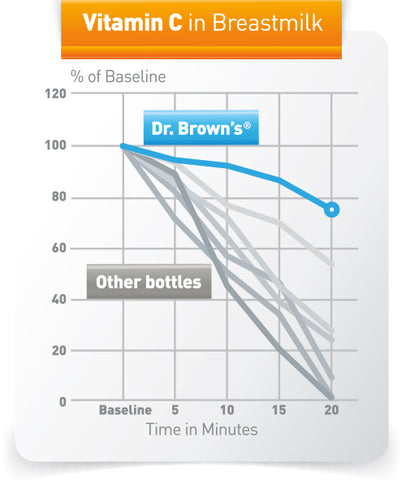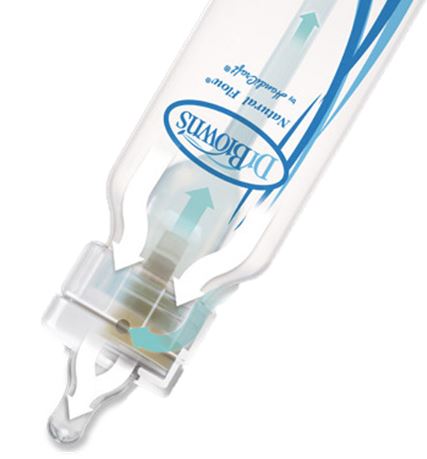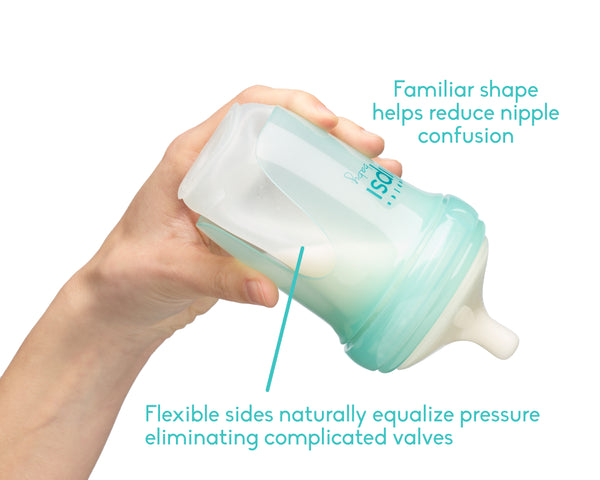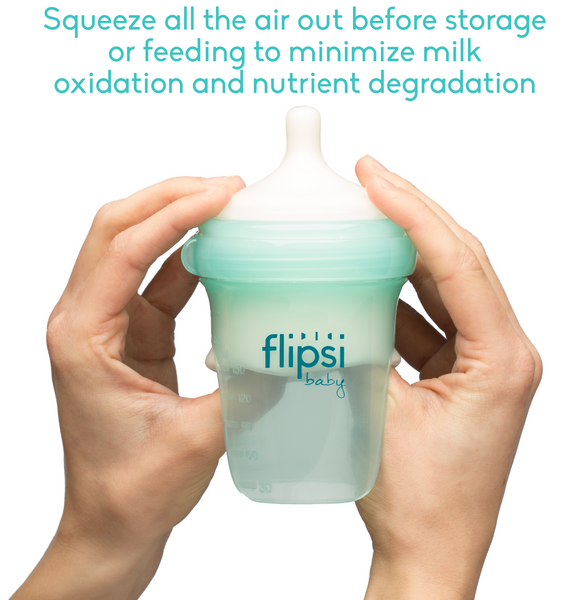The Health Effects Baby Bottles Have on Formula & Baby Milk -
Does using a baby bottle reduce the positive health effect of your breastmilk or baby formula?
Many moms rely on hand expression or pumping so that the milk can be stored and fed to their baby at a later time. How this breastmilk (or formula) is delivered to the baby can have significant impacts on the nutrient levels in the milk.
A study from the University of Nevada by Francis et. al “Decreasing retinol and α-tocopherol concentrations in human milk and infant formula using varied bottle systems” [1] shows that baby bottles where bubble formation is observed during a 20 minute simulated feeding have lower levels of Vitamin A and Vitamin E that bottles where no bubble formation exists.

“By analyzing a 20-minute simulated feeding, retinol and alpha-tocopherol each displayed decreases over time significantly different than that of the Control, which was milk not exposed to bottle feeding.
In human milk, retinol showed as high as a 9.5% decrease compared to the Control. Similar trends were seen with the infant formula samples.
The correlation between degradation and bottle feeding systems was dependent upon the formation of bubbles in the milk as the milk was removed from the bottle. The analysis indicated a decrease of up to 12%, as seen in retinol, and 35%, as seen in alpha-tocopherol. These decreases in retinol and alpha-tocopherol should be considered when using a bottle feeding system to deliver either human milk or formula to an infant.” [1]
In other words - air reduces the level of vitamins in baby milk and formula over time. When a baby bottle exposes a bigger surface of milk contacting air, it reduces these vitamins more quickly.
Vitamin C in Breastmilk:
 [2]
[2]
The Dr. Brown’s bottle was the highest performing bottle in the study, outperforming bottles which vent air through the milk, since it funnels the air needed to equalize the internal pressure past the milk and into the back of the bottle.
While this venting mechanism functions well, the multiple small parts can be difficult to clean.

How Flipsi compares to other baby bottles
Although the Flipsi Baby bottle was not tested as part of this study (it didn’t exist in 2012) it is expected to exceed in nutrient preservation since the Flipsi Baby bottle does not rely on air being vented through the milk to equalize the pressure.
In fact, due to its flexible sides, it doesn’t need any venting at all:

Flipsi bottles also have a unique feature which allows you to squeeze all the air out before storage or feeding to minimize milk oxidation and prevent nutrient degradation.
Babies love the vaccum created, because it prevents them from sucking in air.

Why baby milk vitamins are so important
Vitamin C, A, and E all declined during simulated bottle feeding in as little as 5 minutes [1]. These vitamins are critical for the health and growth of infants.
Vitamin C is important physiological antioxidant and is required for biosynthesis of collagen, an essential part of connective tissue and vital to wound healing [4-6].
Vitamin A is important to combat infections and support rapid growth [7].
Vitamin E is an essential antioxidant to protect and support immune system development [8].
Explore our baby bottles:
References:
[1] J. Francis, K. Rogers, D. Dickton, R. Twedt, R. Pardini, Decreasing retinol and α-tocopherol concentrations in human milk and infant formula using varied bottle systems, Matern. Child Nutr. 8 (2012) 215–224. doi:10.1111/j.1740-8709.2010.00279.x.
[2] https://www.drbrownsbaby.com/nutrient-study/
[3] http://babyrecs.com/wp-content/uploads/2011/12/dr_brown_bottles.jpg
[4] Li Y, Schellhorn HE. New developments and novel therapeutic perspectives for vitamin C. J Nutr 2007;137:2171-84.
[5] Carr AC, Frei B. Toward a new recommended dietary allowance for vitamin C based on antioxidant and health effects in humans. Am J Clin Nutr 1999;69:1086-107.
[6]bFrei B, England L, Ames BN. Ascorbate is an outstanding antioxidant in human blood plasma. Proc Natl Acad Sci U S A 1989;86:6377-81.
[7] http://www.who.int/elena/titles/vitamina_infants/en/
[8] Lima MS, Dimenstein R, Ribeiro KD. Vitamin E concentration in human milk and associated factors: a literature review. J Pediatr (Rio J). 2014;90:440–8.

